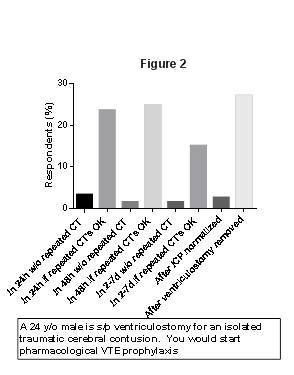B. STROLLO1, G. Bennett1, M. Chopko1, W. A. Guo1 1State University Of New York At Buffalo,Surgery,Buffalo, NY, USA
Introduction: Patients with traumatic brain injury (TBI) are at a significant risk of developing venous thromboembolism (VTE). However, early pharmacologic prophylaxis risks progression of neurological site bleeding. Thus far, no national standard exists to guide for safely initiating pharmacologic prophylaxis of VTE after TBI. We designed this study to survey the EAST members on their practice patterns regarding timing of pharmacologic VTE prophylaxis after TBI.
Methods: Over 1 month, EAST members were emailed to participate in an online survey. Participants reported demographics, and responses to questions regarding VTE prophylaxis and timing of prophylaxis in 2 clinical scenarios of TBI.
Results:The response rate was 30.9%. The majority of the participants were from Level 1 trauma centers and academic teaching hospitals. Most respondents (75%) reported starting chemical VTE prophylaxis with a consensus between the neurosurgery and trauma/critical care services. While 76% of respondents reported experience of seeing pulmonary embolism without pharmacologic VTE prophylaxis, only 44% witnessed progression of TBI after chemical VTE prophylaxis. About half of surgeons surveyed considered their practice of VTE prophylaxis in TBI patients to be conservative. Almost 50% reported no standardized protocol in their institutions. While 1/3 of the members believed there are guidelines from EAST, another 1/3 were not aware of any guidelines available for VTE prophylaxis after TBI. Responses to questions regarding timing of pharmacologic VTE prophylaxis in a hypothetical patient are shown in Figure.
Conclusion:Currently there is a substantial variation in the practice patterns among EAST members regarding timing of pharmacologic VTE prophylaxis in TBI patients. This survey reinforces the need for prospective observational and randomized control trials to determine best practice of VTE prophylaxis in patients after TBI.
